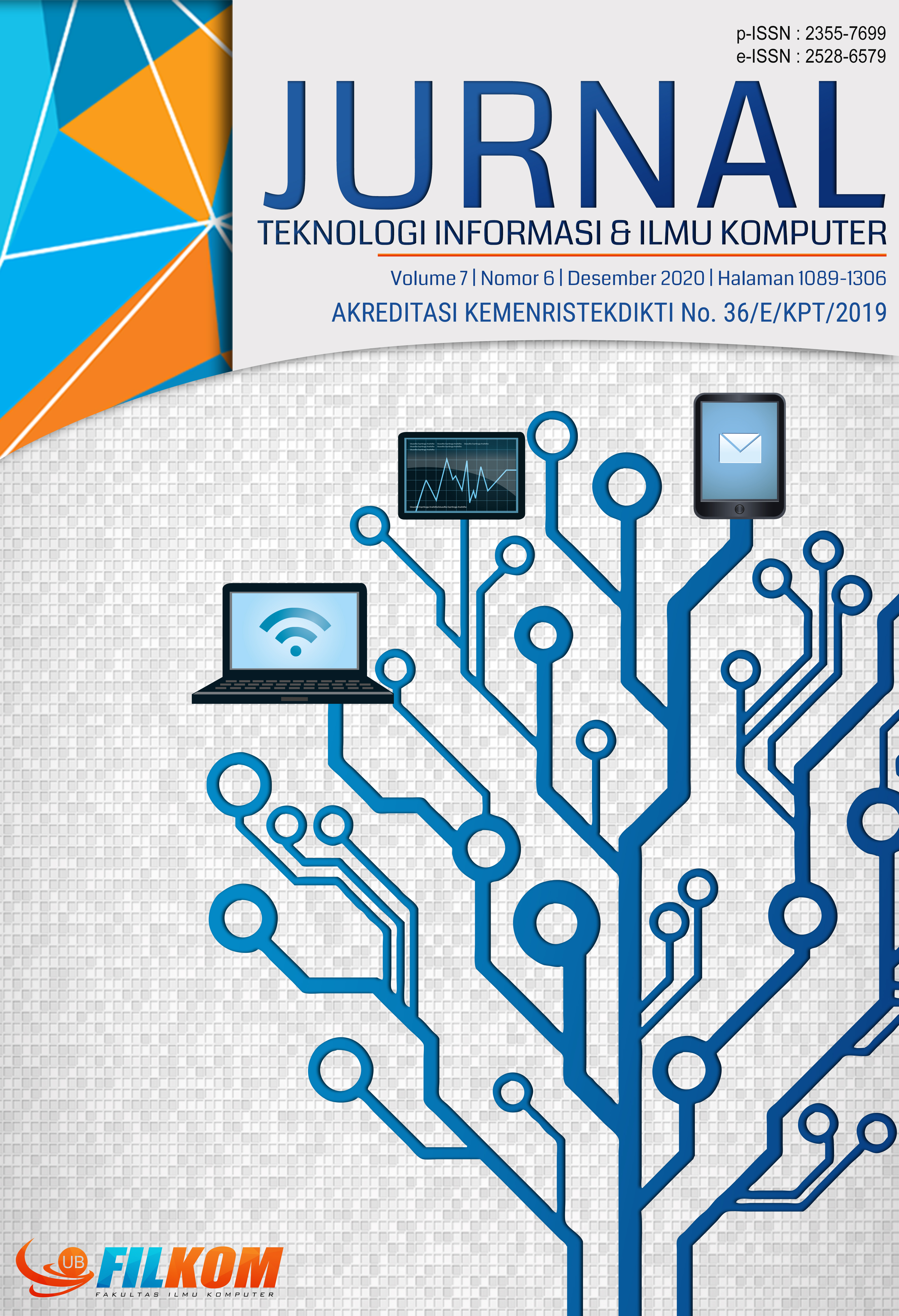Penerapan Animasi 3D pada Media Pembelajaran Mengenal Huruf Vocal untuk Anak 2-4 Tahun
DOI:
https://doi.org/10.25126/jtiik.2020762175Abstrak
Pengenalan huruf vokal bagi anak usia dini harus diperkenalkan sejak dini karena huruf vokal berfungsi untuk merangkai huruf dari kumpulan konsonan yang dijadikan suatu perkataan. Komputer grafis telah berdampak signifikan pada banyak bidang salah satunya animasi komputer. Animasi komputer dapat diimplemantasikan bagi anak untuk belajar karena dalam masa perkembangannya anak memiliki kecenderungan meniru dan mengamati sehingga memudahkan anak dalam menerima materi. Penelitian ini bertujuan untuk merancang dan mengetahui kelayakan animasi 3D pada media pembelajaran mengenal huruf vokal. Metode penelitian menggunakan model pengembangan waterfall meliputi tahapan pra produksi, produksi dan pasca produksi. Tahap pra produksi, (a) penentuan ide dan cerita; (b) desain karakter; (c) storyboard; (d) perekaman suara. Tahap produksi, (a) modeling; (b) texturing; (c) rigging; (d) animating; (e) lighting; (f) camera operation; (g) rendering. Tahap pasca produksi, (a) final editing; (b) hasil video animasi. Media animasi 3D mengenal huruf vokal dikategorikan layak setelah dilakukan validasi oleh 4 ahli media. Hal ini dibuktikan dalam pengujian pertama media didapatkan hasil rata-rata 81% yang berada pada kategori layak dengan catatan revisi sesuai saran. Pengujian kedua setelah media direvisi didapatkan hasil rata-rata 86,5% yang berada pada kategori sangat layak.
Abstract
The recognition of vowels for early childhood needs to be introduced early because the vowels function to string the letters of the consonant groups that are used as words. Based on the observation in KB Syiarul IslamTegal that the learning media know the vowels still use a simple props that is a vocal board attached to the class wall. This makes the child easily saturated and uninterested. In addition there is no media learning in the form of 3D animation. Anticipating these constraints, new learning media is needed using 3D animation. 3D animation can be implanted for the child to learn because in its development period the child has a tendency to emulate and observe so as to facilitate the child in receiving material. In general, this research aims to design and know the feasibility of visual elements (images, writings) and 3D animations on the media learning to know the vocal letters. The research method uses waterfall development model according to M. Suyanto (2006) which includes pre production stage, production and post production. Pre-production stage, (a) determination of ideas and stories; (b) Character design; (c) Storyboard; (d) Voice recording. Production stage, (a) modeling; (b) texturing; (c) Rigging; (d) Animating; (e) Lighting; (f) Camera operation; (g) Rendering. Post-production stage, (a) final editing; (b) The result of animated video. 3D animation Media know the vowels categorized worthy with the assessment of some aspects such as the aspect of image quality, sound quality, media content, objects and characters, background, animation techniques, storyline, and the impression of the video done validation by 4 Media experts. This is evidenced in the first test of the media obtained an average result of 81% which is in decent category with revision notes as per suggestion. The second Test after the revised media obtained an average yield of 86.5% which is in very decent category
Downloads
Referensi
ADENIRAN, E., 2010. Application of Computer Graphics technique to computer systems assemblage, B.Tech Project Report. Nigeria: Department of Computer Science and Engineering, Ladoke Akintola University of Technology
ADEYANJU, I. A., BABALOLA, C. T., SALAUDEEN, K.B., & OYEDIRAN, B.D. (2015). 3D Computer Animation For A Yoruba Native Folktale.
International Journal of Computer Graphics & Animation (IJCGA) 5(3), 19-27.
CAKIROGLU, U., & YILMAZ, H., 2017. Using Videos and 3D Animating for Conceptual Learning in Basic Computer Units. Contemporary Educational Technology 8(4), 390-405.
CHAN, K., 2007. “A Proposed Character Animation WorkflowFor Digital production Arts With Preparation For Cloth Dynamics”, Clemson University. Clemson, South Carolina.
DANIEL, T., 2014. Computer Animation: Computer Graphics Lab, Technical report. Switzerland: Swiss Federal Institute of Technology.
KUMAR, B. S., 2016. 3-D Animation As An Effective Learning Tool. International Research Journal of Engineering and Technology (IRJET) 03(11), 392–394.
Permendiknas Republik Indonesia Nomor 58 Tahun 2009. Standar Pendidikan Anak Usia Dini. 17 September 2009. Jakarta
SUGIYONO, 2015. Metode Penelitian Pendidikan. Bandung: Alfabeta
SUPARTI, W. & SIMATUPANG, N.D., 2016. Meningkatkan Kemampuan Mengenal Konsep Lima Huruf Vokal Melalui Media Aplikasi Power Point Pada Anak Kelompok A. Jurnal PAUD Teratai, 05(03), 197-201.
SUYANTO, 2006. Merancang Film Kartun Kelas Dunia. Yogyakarta:Andi Offset.
UCE, L., 2015. The Golden Age : Masa Efektif Merancang Kualitas Anak. Jurnal Pendidikan Anak, 1(2), 77-92.
WANDINI, R.R., 2017. Pengenalan Huruf Vokal Terhadap Anak Usia Dini dengan MEDIA Audio Visual. Jurnal Tarbiyah, XXIV(1), 120–136.
WANG, Q., 2017. Design of 3D animation special effects in animation 3D modeling teaching based on QFD theory. International Journal of Emerging Technologies in Learning, 12(7), 90–100.
https://doi.org/10.3991/ijet.v12i07.7218
WAYNE, C., 2003. A Critical History of Computer Graphics and Animation, Technical report. USA: The Ohio State University
Unduhan
Diterbitkan
Terbitan
Bagian
Lisensi

Artikel ini berlisensi Creative Common Attribution-ShareAlike 4.0 International (CC BY-SA 4.0)
Penulis yang menerbitkan di jurnal ini menyetujui ketentuan berikut:
- Penulis menyimpan hak cipta dan memberikan jurnal hak penerbitan pertama naskah secara simultan dengan lisensi di bawah Creative Common Attribution-ShareAlike 4.0 International (CC BY-SA 4.0) yang mengizinkan orang lain untuk berbagi pekerjaan dengan sebuah pernyataan kepenulisan pekerjaan dan penerbitan awal di jurnal ini.
- Penulis bisa memasukkan ke dalam penyusunan kontraktual tambahan terpisah untuk distribusi non ekslusif versi kaya terbitan jurnal (contoh: mempostingnya ke repositori institusional atau menerbitkannya dalam sebuah buku), dengan pengakuan penerbitan awalnya di jurnal ini.
- Penulis diizinkan dan didorong untuk mem-posting karya mereka online (contoh: di repositori institusional atau di website mereka) sebelum dan selama proses penyerahan, karena dapat mengarahkan ke pertukaran produktif, seperti halnya sitiran yang lebih awal dan lebih hebat dari karya yang diterbitkan. (Lihat Efek Akses Terbuka).















